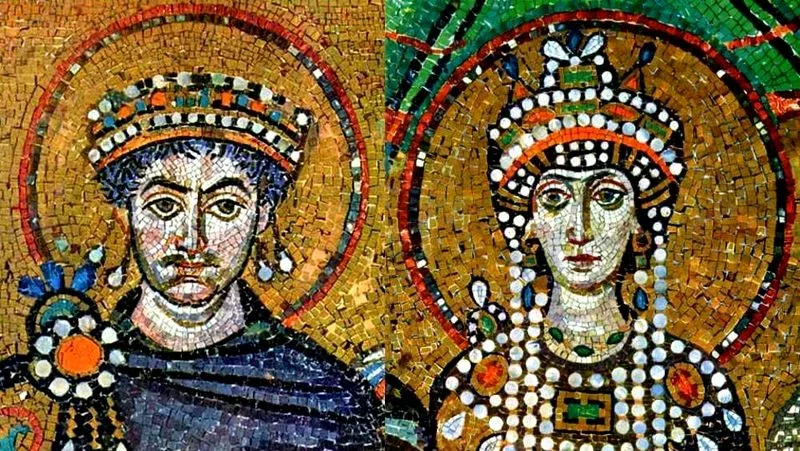Nowadays Ravenna is famed for its magnificent mosaics but this amazing city contains other artistic treasures besides mosaics some of whom have been listed heritage of humanity by UNESCO! As soon as Ravenna became capital of western Roman Empire,to wit from 402 to 751, in this city it developed a peculiar art which was expressed not just with mosaics but also in architcture and ivory sculpture. The emperor Honorius moved the capital from Mediolanum(Milan),which in that period was threatened by Visigoths, to Ravenna since this last had a series of advantages among which a better protection from foreign attacks thanks to the presence of several lagoons which surronded the city and that made it almost impenetrable. In the new capital started from the outset, new impressive buildings as Ursiana basilica of whom remains only some ruins embedded in the Duomo of Ravenna and the Neonian Baptistery whose name comes from bishop Neone which made it decorate with several mosaics approximately in 458. When the emperor Honorious died took over as regent Galla Placidia who ruled on behalf of her minor son Valentinian III. The age of Galla Placidia rediscoverevered some elements of Constantine era indeed in the church of Saint John the Evangelist you can notice the presence of pulvini which would be trunks of inverted pyramid above the capitals of columns that in fact become more slender and elegant. Afterwards you can notice the presence of two rectangular rooms on the sides of the lateral aisles called pastophoria that had the function of the current sacristies. In this period the most famous and important monument that we have to remember is so called Mausoleum of Galla Placidia even though some historians believe that it was erected in honor of Saint Lawrence since some historical sources report that Galla Placidia died and was buried in Rome. Mausoleum is composed by a central dome that overlooks the building whose sides include four lunettes in which are painted pictures of saints and apostels who adore the Cross placed in the centre of the dome on a blu background full of stars. This cycle of mosaics survived to our day intact but only because of continuing restoration work that during the centuries allowed to such masterpieces to be admired to nowadays eyes.
After the fall of Western Roman Empire in 476 caused by the constant invasions of barbarian populations as Visigoths,Longobards and Ostrogoths,Ravenna was taken over by ostrogothic ruler Theodoric who began a remedetion policy of territories and moreover he organized his kingdom in a different way compared to other barbarian kingdoms. With a great merit, Theodoric managed to create a peaceful coexistence between Goths and Latins holding distant the two ethnicities and allowing the two different cults that these practiced. Goths were Aryans by religion whereas Latins were Christian therefore this involved livind in separate neighbourhoods and the specific construction of buldings for worship,each for their own religion. Near the Palace of Regio Caesaris were built a basilica and a baptistery later called baptistery of aryans both decorated with wonderful mosaics. At the beginning of the 6th century was erected the famous basilica of Saint Apollinare composed of three aisles a longitudinal plan that had wiindows both on the ground floor and in cleristory.Even this basilica is decorated by magnificent mosaics some of whom, unluckly,been lost. An important monument listed as a World Heritage by UNESCO is the chapel of Archbishop’s Palace and it is even the only Orthodox monument built under the reing of Theodoric. This last one ordered to built his own mausoleum in 520 which still today we can admire isolated nearby Ravenna. The peculiarity of such building is that it was not built with brick but with the help of blocks of istria stone but not only,it stand out even for its ceiling built with a single and huge monolith than in its turn is decorated by pincer motifs rapresenting thereby the only example of barbarian jewellery in Ravenna city. This last one was proclaimed capital of Italy with the seizure of power by Justinian which gave the go ahead to so called Gothic wars and furthermore he tried by all means, to erase the period of Ostrogoth usurpation and even the Aryan religion. They started with the church of New Saint Apollinare that was redecorated on the basis of Catholic Christian cult indeed mosaics were recreated on the style of coeval byzantine art.

Beside basilicas and mosaics we need to mention other artistic artefacts like furnishings,sarcophagi and liturgical objects.Among them stand out the bishop’s chair of Massimianus created between 546 and 556 with carved ivory panels. As concerns art of the sarcophagi in Ravenna stand apart sarcophagi carved with human figures and those carved with symbolic animal figures and crosses. Among the most important there are sarcophagus of church of Saint Francis and sarcophagus with Christ between Peter and Paul. Ravenna’s sarcophagi stand ou from those romans for a greater monumentality that not only affects just the size but even a stronger decorative focus placed on the sarcophagus cover.
Conclusions
Ravenna’s art developed in golden age of Ravenna capital of Western Roman Empire and, as all kind of art of that time, mostly produced religious art which had not just christian and byzantine influences but also barbaric as evidenced by age of Theodoric,ostrogoth king,which sponsored in Ravenna aryan religion. Ravenna has been enriched by the contruction of churchs and basilicas which in turn have been embellished by the presence of several mosaics which have made Ravenna famous all over the world!
